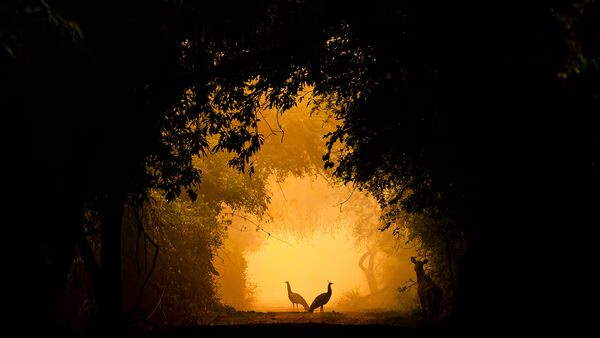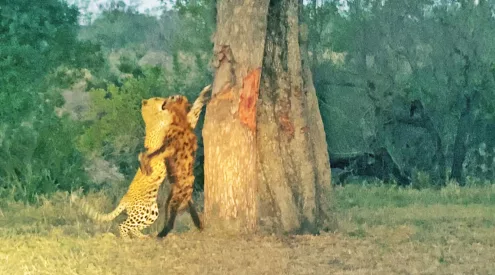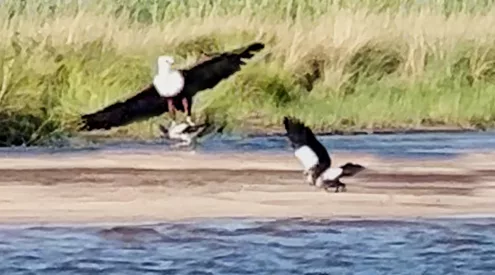We are on our way to Liuwa National Park in Zambia to experience the wildebeest migration. The park covers an area of 3,660 square kilometres of vast wooded islands, 70 kilometres long and 30 kilometres wide. The area forms part of the Western Zambian grasslands and is bounded by the Luambimba and Luanginga rivers. It consists of grassy plains with numerous pans; home to a variety of animals, including large mammals such as blue wildebeest and tsessebe. The park plays a vital role in the Zambezi’s catchment and is flooded from late December to June each year making it attracting diverse bird life.
But we are here for ‘The Migration‘. As we drive off the hand-drawn ferry onto the plains of Liuwa; I am filled with a sense of freedom and anticipation. I have been longing for this day and a quick feeling of doubt is pushed right out of my mind by the sheer vastness of this National Park. You can see so far all around you that I swear I could actually see the curvature of the earth. We are in for a treat!
As we drive along the 20 or so kilometres to our base camp the story of ‘The Last Lioness’ runs through my brain and I wonder if she has adapted with her new mates or whether we will even see her. But that is another story. We are here for a purpose and will remain focused on these animals, the mighty blue wildebeest….
The next morning we rose at the crack of dawn with great expectations and headed out into the northern areas of the park. Liuwa doesn’t have many landmarks, other than The Sausage Tree, The Palm (and believe me it is the only palm in the park), and Pelican Pan, where there is an abundance of bird species, particularly during the rainy season. These include large populations of the endangered wattled and grey-crowned cranes, marabou stork and pelican as well as migratory birds. The presence of these and other species, including Southern ground hornbill, Bateleur and Martial eagle, make Liuwa an important bird conservation area.
We drive past them in ones and twos and then in the distance we start seeing them in their hundreds. As we get closer we notice that for almost every adult wildebeest there is a young beige juvenile at her side. The young males on the outskirts fool around, running up and down the perimeters kicking up the dust, making for awesome photography. We drive closer and closer and I can hardly believe what we are seeing… This is like a steady procession rather than a frenetic rush. The groups stop and eat along the way. There must be at least 10,000 of these animals as far as the eye can see and this doesn’t include the several thousand new-born calves. These animals are on a mission heading south to where the thunderstorms are building.
The night before we watched dramatic cloud formations erupting in the skies and this morning again the lightning bolts created spectacular skylines, beckoning to the wildebeest. They know that the long trek will be worth it once the new sweet-grass breaks through ground surface after the rains start falling.
We sit in stunned silence watching the procession taking place before our eyes; totally unhurried but never veering off course. Suddenly I notice a female lagging behind and walking awkwardly. I focus my 100-400mm lens on her and a sense of excitement fills me. She is about to give birth. My husband and I both set up to capture this “once in a lifetime” opportunity, him on video and me with a series of stills, trying to be methodical and meticulous but bursting with excitement and anticipation inside.
A series of events unfold in all of ten minutes. From the start of the birth to the newborn’s first steps. The entire herd moves on slowly and once the female has given birth she anxiously encourages and coaxes the baby to her feet so that they are not left behind. During the entire ordeal she keeps looking across to us where we have cameras rolling. The baby is not keen to rise to her feet and slumps down into the ground wanting to sleep. The mom desperately licks her face and makes sounds that only another mom can understand. Tears start rolling down my face as I realize that if she doesn’t get up and walk soon the mom will have to rejoin her herd and leave her to the fate of so many others that are too weak to carry on.
I watch as the mother turns and walks off but she only takes a few steps and then goes back to her baby. She licks her face again and then the little one struggles to her feet, but in a second she is back down again. The mom licks her again and prompts her to try again. I am just pressing the shutter button continuously and try to wipe the tears from my eyes so that I can refocus on the calf. She is up again and takes a step. Her mom at her side continually prompts her and then two other adults from the group come running back to fetch them. They gather on either side of the baby and encourage her to move along to the group.
Suddenly the calf sees more calves in front of her and she stumbles along towards the herd. With her mother at her side nudging her into the middle of the group she soon disappears into the safety of the numbers.
I look at my husband and we both smile at each other and wipe our eyes. I think I’ll call her Baby Rose, I say triumphantly…..
“What a day! What a place!”


















